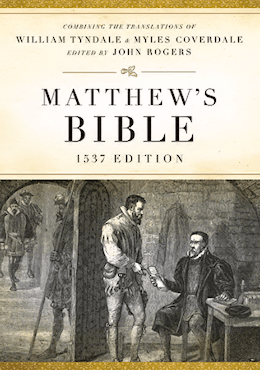Textus Receptus Bibles
Matthew's Bible 1537
| 1:1 | That whyche was from the begynninge, whyche we haue hearde, whyche we haue sene with oure eyes, which we haue loked vpon and our handes haue handeled, of the word of the lyfe. |
| 1:2 | For the life appeared, and we haue sene, and beare wytnes, and shewe vnto you that eternall lyfe, whyche was wyth the father, and appeared to vs. |
| 1:3 | That whyche we haue sene and hearde declare we vnto you, that ye maye haue felowshyp wyth vs, and that our felowshype may be wyth the father and hys sonne Iesus Christ. |
| 1:4 | And this wryte we vnto you that youre ioye may be ful. |
| 1:5 | And this is the tydinges that we haue heard of him, and declare vnto you, that God is lyghte and in him is no darckenes at al, |
| 1:6 | yf we saye that we haue felowshippe with him, and yet walke in darckenes, we lye, and do not the trueth, |
| 1:7 | but and yf we walke (in light) euen as he is in lighte, then haue we felowshyppe wyth hym, and the bloude of Iesus Christe his sonne clenseth vs from all sinne. |
| 1:8 | If we saye that we haue no sinne, we deceiue oure selues, and trueth is not in vs. |
| 1:9 | If we knowledge oure sinnes, he is faythfull and iust, to forgeue vs our sinnes, and to clense vs from al vnrightuousnes. |
| 1:10 | If we say we haue not sinned, we make him a liar, and his word is not in vs. |

Matthew's Bible 1537
The Matthew Bible, also known as Matthew's Version, was first published in 1537 by John Rogers, under the pseudonym "Thomas Matthew". It combined the New Testament of William Tyndale, and as much of the Old Testament as he had been able to translate before being captured and put to death, with the translations of Myles Coverdale as to the balance of the Old Testament and the Apocrypha, except the Apocryphal Prayer of Manasses. It is thus a vital link in the main sequence of English Bible translations.